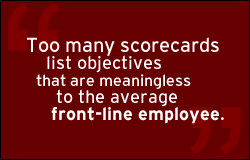The first article of this two-part series reviewed the concept of the balanced scorecard management approach. Introduced by Robert Kaplan and David Norton in a 1992 Harvard Business Review piece, the balanced scorecard is designed to connect an organization's employees to its overall business strategy. The scorecard does this by balancing performance measures and actions across financial, customer, internal process, and learning and growth dimensions.
To make the balanced scorecard work, however, companies must manage four crucial elements effectively -- and many don't. The previous article discussed the importance of two of these elements: focus -- making sure the scorecards zero in on the most crucial outcomes that companies must manage, and validity -- ensuring that all metrics actually measure the right things. Companies must manage these elements on their scorecards to steer the organization in the right direction. (See "Making the Balanced Scorecard Work (Part 1)" in See Also.)
 |
This article examines the remaining elements: connectivity and integration. Without these elements, a scorecard is just a set of data that fails to link employees' priorities and behaviors to their businesses' most important outcomes.
Connectivity
Many organizations use balanced scorecards only at the corporate or business-unit levels, neglecting to connect individual departments, workgroups, managers, and employees to their overall strategy. Although this approach can be effective in focusing the actions of the leadership team, it doesn't make an impact deep enough in the organization. A company must clearly communicate its strategy to all of its stores, plants, or facilities. If it doesn't do this, the front-line teams that ultimately determine the productivity and service capacity of the business won't necessarily align their day-to-day activities with corporate goals.
For example, too many scorecards list objectives such as "reducing costs," "increasing productivity," or "providing service excellence." These objectives may seem sensible to a senior manager, but they're meaningless to the average front-line employee. Instead, objectives must be translated into measures that are specific, tangible, and actionable.
In their attempt to be specific, many companies get sidetracked into legislating activities, behaviors, or milestones, losing focus on the outcomes they are after. Outcomes represent results -- they quantify success. It's your job to hold people accountable for their outcomes. Activities, on the other hand, are the inputs or steps that lead to the desired outcomes. You train, coach, or manage a person on these activities in a way that works for the individual.
Unfortunately, companies often get this backward. Instead of defining outcomes and managing activities, some companies legislate a long list of activities in the hope that this will achieve the desired outcomes. But instead of instilling consistency and establishing accountability, the activities become the outcomes. These associated activity-based measures often lack validity, which only makes the problem worse.
The key is to manage activities and outcomes differently -- and in the right way. Start by defining the outcomes for each role -- outcomes that are aligned with the overall corporate strategy -- and the metrics you'll use to measure success. Then manage your employees' activities -- the steps they take to achieve those outcomes -- individually. All employees are different, and they'll approach achieving their outcomes in very different ways.
The key is to measure the real outcomes as locally as possible. Then, manage the activities, person by person, with absolute flexibility and full individualization. This will free your employees to achieve measurable results in the ways that work best for them -- and your company.
Integration
To implement the balanced scorecard effectively, companies must integrate it into their performance management and development practices. It's not uncommon for companies to develop scorecards that lack accountability. Sometimes, scorecards and performance incentive systems are linked, but the ways that managers evaluate employees are completely unrelated. Other times, the corporate university develops courses that are linked to the past, not the future.
Proper integration is essential for a balanced scorecard initiative to succeed. The balanced scorecard has important implications for resource allocation. It forces companies to identify irrelevant activities and allocate resources instead to a few mission-critical outcomes. One company's call center, for example, instituted several policies and processes that impeded front-line employees from providing excellent customer service. To correct this problem, they moved away from emphasizing compliance and keeping calls as short as possible to actually solving the customers' problems and making each customer feel unique.
Once a company has identified its key activities, its new performance outcomes must be linked to rewards, including incentives, recognition, and prestige. And employees who consistently underperform should be encouraged -- and required, if necessary -- to find new roles that better fit their knowledge, skills, and talents. Training programs should educate employees about the required outcomes for their roles and introduce new practices and processes. More importantly, coaching and development approaches must help employees understand how they can achieve their goals in their own unique way.
For integration to succeed, senior executives must be committed to aligning people and processes with corporate goals -- and eliminating any barriers to success. Too often, silos prevail and politics dominate. When they do, the balanced scorecard approach fails.
Nothing powerful ever comes easy
When implemented properly, the balanced scorecard is a powerful approach. Ignoring the four key elements -- focus, validity, connectivity, and integration -- all but guarantees failure.
As with anything that matters, time and dedication are required to make the balanced scorecard work. But making it work can mean the difference between mediocrity and success.